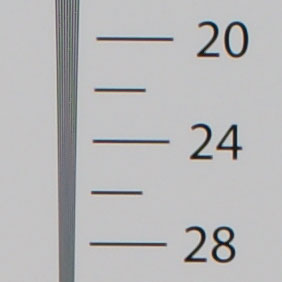Sony Alpha DSLR-A300
-
-
Written by Gordon Laing
Sony Alpha DSLR-A300 resolution comparison
| Support this site by shopping via these links | ||||||||||||||||||||||||||||||||||||||||||||||
Note: Sony has asked us to describe our A300 as a pre-production model, although supplied in retail packaging and running Firmware version 1.0, we’re confident the output is close or even identical to what you’ll get with final production units. We will update this page with samples from a retail A300 when one becomes available. The A350 and Canon 450D samples below are from final production models.
 |
To measure and compare the Sony Alpha DSLR-A300’s resolving power we photographed the Enhanced Digital Camera Resolution Chart with it and a number of rival cameras, each using their best quality JPEG and default image tone and sharpening settings. Each camera was tested at every aperture setting and the best result selected for this page. The crops are taken from the original images, saved as High Quality JPEGs in Photoshop CS2 and presented here at 100%. Each number represents 100 lines per picture height (lpph), so a figure of 20 means a resolution of 2000 lpph. |
In terms of resolving power, the Sony Alpha DSLR-A300 delivers 2100 lpph of horizontal and vertical resolution when equipped with the standard DT 18-70mm kit lens. This, as we’d expect is identical to the Sony Alpha DSLR-A200, as both models share the same 10 Megapixel sensor and image processor. The minor differences between the A300 and A200 samples seen below are down to different copies of the DT 18-70mm lens, and different production levels for the models tested. By scoring the same as the Alpha A200, the new A300 is ranked towards the top of the current crop of 10 Megapixel DSLRs, and like these, you’ll be able to squeeze out greater resolution by fitting a higher quality lens like the Sony DT 16-80mm. Indeed the A200 / A300 equipped with a decent lens will approach the resolution of the 12 Megapixel Canon 450D / XSi with its kit lens – although again, fit the Canon with something better and you’ll enjoy superior results. Finally, the 14 Megapixel Sony Alpha A350 unsurprisingly scores highest in this test, even when equipped with the ageing kit lens. So as you’d expect, the 10, 12 and 14 Megapixel DSLRs represented below deliver increasingly higher resolutions, although the differences in real-life recorded detail can be subtle as seen on the previous results page. Scroll down to see how shooting in RAW can affect this test, or head straight over to our real-life noise results to see how it performs across its sensitivity range. |
Sony Alpha DSLR-A300 with DT 18-70mm |
Sony Alpha DSLR-A350 with DT 18-70mm | |
 |  | |
2100 lpph, DT 18-70mm at 35mm, f8, 100 ISO |
2500 lpph, DT 18-70mm at 35mm, f8, 100 ISO | |
Sony Alpha DSLR-A200 with DT 18-70mm |
Canon EOS 450D / XSi with EF-S 18-55mm IS | |
 |  | |
2100 lpph, DT 18-70mm at 35mm, f8, 100 ISO |
2200 lpph, EF-S 18-55mm IS at 35mm, f8, 100 ISO |
Sony Alpha DSLR-A300 with DT 18-70mm |
Sony Alpha DSLR-A350 with DT 18-70mm | |
 |  | |
2100 lpph, DT 18-70mm at 35mm, f8, 100 ISO |
2250 lpph, DT 18-70mm at 35mm, f8, 100 ISO | |
Sony Alpha DSLR-A200 with DT 18-70mm |
Canon EOS 450D / XSi with EF-S 18-55mm IS | |
 |  | |
2100 lpph, DT 18-70mm at 35mm, f8, 100 ISO |
2225 lpph, EF-S 18-55mm IS at 35mm, f8, 100 ISO |
Sony Alpha DSLR-A300 Studio resolution: JPEG versus RAW
We photographed our test chart in the A300’s RAW plus Large Fine JPEG mode, allowing us to directly compare images created from exactly the same data. Below are crops taken from the RAW file converted using Sony’s supplied Image Data Converter SR 2.0 using its default settings.
Using the default settings, it’s clear the RAW samples converted with Sony’s software suffer from greater moiré than the in-camera JPEGs, reducing the maximum resolution. Interestingly, this was exactly the same effect seen with the earlier Alpha A350 and A700. Clearly anyone who shoots RAW will need to do some tests to find the best workflow for converting their A300 files.
Now let’s check out the camera’s performance at different sensitivities in our Sony A300 noise results page.
Sony Alpha DSLR-A300 JPEG with DT 18-70mm |
Sony Alpha DSLR-A300 RAW with DT 18-70mm | |
 |  | |
2100 lpph, DT 18-70mm at 35mm, f8, 100 ISO |
2000 lpph, DT 18-70mm at 35mm, f8, 100 ISO |
Sony Alpha DSLR-A300 JPEG with DT 18-70mm |
Sony Alpha DSLR-A300 RAW with DT 18-70mm | |
 |  | |
2100 lpph, DT 18-70mm at 35mm, f8, 100 ISO |
2000 lpph, DT 18-70mm at 35mm, f8, 100 ISO |




